In advance of March 14, the start of free agency in the NFL, Pro Football Rumors will detail each team’s three most glaring roster issues. We’ll continue this year’s series with the Minnesota Vikings, who stormed back to contention and ventured to their first NFC championship game since the 2009 season.
Depth Chart (via Roster Resource)
Pending Free Agents:
- Joe Berger, OL
- Sam Bradford, QB
- Teddy Bridgewater, QB
- Tramaine Brock, CB
- Mack Brown, RB (ERFA)
- Nick Easton, OL (RFA)
- Michael Floyd, WR
- Kai Forbath, K
- Anthony Harris, S (ERFA)
- Case Keenum, QB
- Tom Johnson, DT
- Emmanuel Lamur
- Jerick McKinnon, RB
- Terence Newman, CB
- Jeff Overbaugh, LS (ERFA)
- Bishop Sankey, RB (RFA)
- Marcus Sherels, CB
- Jeremiah Sirles, G (RFA)
- Shamar Stephen, DT
Top 10 Cap Hits for 2018:
- Xavier Rhodes, CB: $13,400,000
- Anthony Barr, LB: $12,306,000
- Everson Griffen, DE: $11,600,000
- Riley Reiff, T: $11,400,000
- Harrison Smith, S: $10,000,000
- Linval Joseph, DT: $8,050,000
- Kyle Rudolph, TE: $7,675,000
- Sharrif Floyd, DT: $6,757,000
- Latavius Murray, RB: $6,350,000
- Jarius Wright, WR: $4,760,000
Other:
- Projected cap space (via Over the Cap): $56,497,939
- 30th pick in draft
- Must exercise or decline 2019 fifth-year option for CB Trae Waynes
Three Needs:
1) Pick a quarterback option: Over the past decade, the Vikings have been one of the more unique NFL teams. While playoff brackets are annually populated by teams with long-term solutions at quarterback, the Vikings have managed to be a frequent presence in NFC postseasons without one. Since 2008, Minnesota’s booked playoff berths with five different quarterbacks, with each — Tarvaris Jackson (2008), Brett Favre (’09), Christian Ponder (2012), Teddy Bridgewater (’15) and Case Keenum (’17) — of Keenum’s predecessors never repeating that feat with the team.
 Due to his status entering the season, Keenum may have been the unlikeliest of this contingent to be a playoff quarterback. But he elevated the Vikings to a borderline-dominant regular season and was involved in one of the most improbable moments in NFL history. He’s one of the Vikes’ three UFA QBs, assuming Bridgewater’s contract does not toll, but not a certainty to come back. Keenum departing would add to that unique list of one-and-done Vikings playoff QBs, but he’s a key component in a complex decision-making process.
Due to his status entering the season, Keenum may have been the unlikeliest of this contingent to be a playoff quarterback. But he elevated the Vikings to a borderline-dominant regular season and was involved in one of the most improbable moments in NFL history. He’s one of the Vikes’ three UFA QBs, assuming Bridgewater’s contract does not toll, but not a certainty to come back. Keenum departing would add to that unique list of one-and-done Vikings playoff QBs, but he’s a key component in a complex decision-making process.
The Vikings have decided not to place the franchise tag on Keenum and are now heavily connected to Kirk Cousins, who would stand to be the kind of long-term solution Minnesota has sought since Daunte Culpepper. Winning this unique race would leave other franchises scrambling. But how committed are the Vikings to make Cousins the highest-paid player in NFL history when they’ve been arguably the best team at making do without such an expense on their payroll?
As a starter, Cousins has as many playoff berths as the rest of the players on the Vikings’ modern-era QB list. But an argument could be made paying him approximately $30MM per year is safer than authorizing a long-term deal for Keenum at a starter-level price. Cousins has submitted multiple above-average seasons, holds single-season Redskins passing records and played well despite working for one of the least stable organizations in American sports.
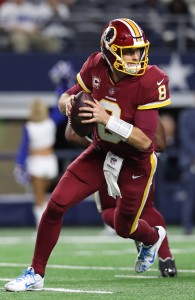 However, Minnesota should understandably be leery of Cousins becoming the next Joe Flacco: a talented but unspectacular passer who used extraordinary circumstances to land a monster contract — the kind that can make finding supporting-cast help difficult and harm salary caps. However, it’s not like the Vikings didn’t have franchise-QB money on their 2017 books. Their three passers took up more than $22MM of the ’17 payroll. Only six teams paid more to quarterbacks last season than the Vikings did. And a Cousins $30MM-per-year (or close to it) deal wouldn’t comprise a significantly greater percentage of the Vikings’ cap in a $177.2MM-cap universe than recent QB contracts.
However, Minnesota should understandably be leery of Cousins becoming the next Joe Flacco: a talented but unspectacular passer who used extraordinary circumstances to land a monster contract — the kind that can make finding supporting-cast help difficult and harm salary caps. However, it’s not like the Vikings didn’t have franchise-QB money on their 2017 books. Their three passers took up more than $22MM of the ’17 payroll. Only six teams paid more to quarterbacks last season than the Vikings did. And a Cousins $30MM-per-year (or close to it) deal wouldn’t comprise a significantly greater percentage of the Vikings’ cap in a $177.2MM-cap universe than recent QB contracts.
Peyton Manning‘s $19.2MM-AAV contract represented approximately 15.5 percent of Denver’s 2012 cap (in a $123MM-cap universe), and Aaron Rodgers‘ $22MM-per-year extension (16.5 percent of the ’13 Packers’ cap) turned out to be a team-friendly accord considering Rodgers’ talents and where the cap went in the coming years. Matthew Stafford‘s $27MM-AAV re-up actually comprised less of the 2017 Lions’ payroll than Rodgers’ 2013 deal did of Green Bay’s. While Cousins’ guarantees will likely be surpass Stafford’s record $60MM, a deal for the soon-to-be 30-year-old QB wouldn’t be that far out of step with recent-past agreements.
Cousins is not on the Rodgers/Drew Brees/Tom Brady/Ben Roethlisberger tier and it’s arguable he may never reliably be a top-10 passer, either. But it will cost more to pay him than it will any other NFL player to date. And the advanced-metrics community did not enjoy Cousins’ 2017 season.
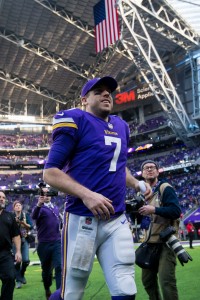 Although, he was deprived of the kind of weapons he had in 2016 (or the kind he’d have in Minnesota). Cousins led the NFL with 1,359 yards on deep throws in 2016, but that figure — per Pro Football Focus — dropped to 825 last season. His adjusted completion percentage dropped from 51 to 40 on deep throws, and his third-down grade ranked 31st (Twitter link; h/t Matthew Coller of ESPN1500). PFF tabbed Cousins as the No. 19 QB last season. Football Outsiders slotted the then-Redskins passer 16th in DYAR — 12 spots behind Keenum, and no team has more intel on Keenum’s ceiling than the Vikings.
Although, he was deprived of the kind of weapons he had in 2016 (or the kind he’d have in Minnesota). Cousins led the NFL with 1,359 yards on deep throws in 2016, but that figure — per Pro Football Focus — dropped to 825 last season. His adjusted completion percentage dropped from 51 to 40 on deep throws, and his third-down grade ranked 31st (Twitter link; h/t Matthew Coller of ESPN1500). PFF tabbed Cousins as the No. 19 QB last season. Football Outsiders slotted the then-Redskins passer 16th in DYAR — 12 spots behind Keenum, and no team has more intel on Keenum’s ceiling than the Vikings.
A Keenum re-up would be banking on the 30-year-old signal-caller being able to continue his out-of-nowhere progression and do so without Pat Shurmur. It wouldn’t cost as much as a Cousins contract, but considering Keenum’s resume as either a backup or stopgap in his five-year pre-Twin Cities career, his future is harder to project than Cousins’. That makes Keenum’s market difficult to determine.
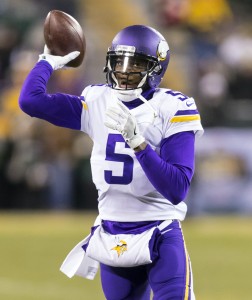 The Vikings not tagging him could make Keenum — whose 2017 season (22 TD passes, seven INTs, 7.6 yards per attempt, and a 67.6 percent completion rate) made him look like a different quarterback — more open to deals outside of Minnesota. Fellow Cousins chaser Denver has been linked to Keenum at multiple junctures. Football Outsiders was sold on Keenum’s 2017 work, for what it’s worth, placing his 1,298 DYAR behind only Brady, Philip Rivers and Brees — and nearly 900 yards north of Cousins’ figure.
The Vikings not tagging him could make Keenum — whose 2017 season (22 TD passes, seven INTs, 7.6 yards per attempt, and a 67.6 percent completion rate) made him look like a different quarterback — more open to deals outside of Minnesota. Fellow Cousins chaser Denver has been linked to Keenum at multiple junctures. Football Outsiders was sold on Keenum’s 2017 work, for what it’s worth, placing his 1,298 DYAR behind only Brady, Philip Rivers and Brees — and nearly 900 yards north of Cousins’ figure.
Mike Zimmer is a known Bridgewater defender. Despite the former first-round pick not exactly lighting it up during Minnesota’s 2015 playoff season (14 TD passes, nine INTs in 16 starts), the Louisville product saw career-defining injuries deny him the chance to show further growth. Having two full seasons taken away from him, the 25-year-old QB now profiles as a stopgap option in free agency or a high-end backup. But the Vikings could well be the team that takes him on as a reserve.
The Vikings’ decision could well shape the quarterback market. Minnesota has proven it can manage without the services of franchise quarterback, but securing one could elevate the franchise to a higher level.
2) Identify extension candidates: Part of the reason the Vikes could be hesitant to throw a king’s ransom at Cousins is its 2019 free agent class. It’s one of the best in the league and contains several core performers. Set for UFA status a year from now: Anthony Barr, Stefon Diggs, Danielle Hunter, Trae Waynes and Eric Kendricks.
With a Cousins-Bridgewater setup, the Vikings will be hard-pressed to keep everyone here. But that wouldn’t be likely even if the team went with Keenum and Bridgewater. However, with the 2019 cap likely to settle in at around $190MM, making these kind of plans has become easier than it was in previous stretches.
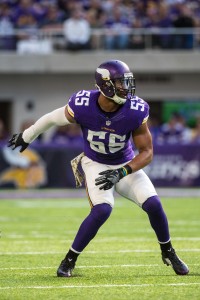 The Vikings obviously showed last summer — when deals came in for Everson Griffen, Xavier Rhodes and Linval Joseph — they’re proactive in locking down homegrown talent. Considering the impending contract-year contingent was brought in under Zimmer, it can be assumed there will be high priorities placed on extending these performers — each a starter-to-be on one of the Super Bowl LIII frontrunners. And it’s interesting how dedicated the Vikes were to locking down non-Zimmer draftees in 2017, but it can be safely estimated some of these players will be signed to long-term agreements before they become UFAs.
The Vikings obviously showed last summer — when deals came in for Everson Griffen, Xavier Rhodes and Linval Joseph — they’re proactive in locking down homegrown talent. Considering the impending contract-year contingent was brought in under Zimmer, it can be assumed there will be high priorities placed on extending these performers — each a starter-to-be on one of the Super Bowl LIII frontrunners. And it’s interesting how dedicated the Vikes were to locking down non-Zimmer draftees in 2017, but it can be safely estimated some of these players will be signed to long-term agreements before they become UFAs.
Waynes can be kept via fifth-year option worth around $9MM, so that would put off any decision on him. But the remainder of this quintet will force some interesting decisions.
The Vikings have expressed interest in extending Barr and Kendricks, although it would seem likely only one of them stays. Barr is set to play on his fifth-year option of $12.3MM. Being a three-time Pro Bowler and one of the best non-rush linebackers in the game, Barr would probably take priority over Kendricks in a one-or-the-other scenario. Barr appears likely to eclipse Jamie Collins ($12.5MM AAV) and be the new market standard for 4-3 outside ‘backers. He’s two years younger, has been a more consistent player and has shown durability that’s helped Minnesota’s defense fuel two playoff runs in three years.
 Kendricks has also been a solid component in Minnesota and for a team that as of now does not have a surefire answer at its third linebacker spot. But that can be addressed rather cheaply in free agency, and given the way the Vikings have drafted and worked free agency in recent years, finding a replacement for Kendricks next year shouldn’t be a grave concern. He would be a coveted commodity on the 2019 market, although he almost certainly won’t fetch what Barr will.
Kendricks has also been a solid component in Minnesota and for a team that as of now does not have a surefire answer at its third linebacker spot. But that can be addressed rather cheaply in free agency, and given the way the Vikings have drafted and worked free agency in recent years, finding a replacement for Kendricks next year shouldn’t be a grave concern. He would be a coveted commodity on the 2019 market, although he almost certainly won’t fetch what Barr will.
Nothing’s emerged yet on the Diggs extension front, but the 2015 fifth-round pick will not come cheap. He proved to be a wise investment and had his most productive season in 2017 — 64 receptions, 849 yards, career-high eight TDs. The Vikings, though, found even stranger receiver value in Adam Thielen, with the UDFA out of Division II ripping off a 91/1,276/4 season campaign to usurp Diggs as the team’s WR1. But Thielen signed for less than $6MM per year, which could complicate matters among Minnesota’s WRs.
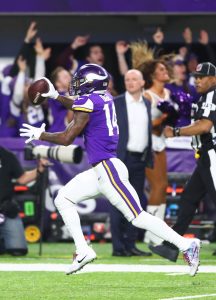 He already has two seasons with more yards than any of Diggs’. Thielen led the Vikes in receiving the past two years, however, but Diggs will surely command eight figures per season. High-end WR2s go for at least $11MM per year, and with both Emmanuel Sanders and DeSean Jackson being far older than the 24-year-old Diggs, this negotiation could be tricky for both of the Vikings’ starting wideouts.
He already has two seasons with more yards than any of Diggs’. Thielen led the Vikes in receiving the past two years, however, but Diggs will surely command eight figures per season. High-end WR2s go for at least $11MM per year, and with both Emmanuel Sanders and DeSean Jackson being far older than the 24-year-old Diggs, this negotiation could be tricky for both of the Vikings’ starting wideouts.
Laquon Treadwell remains in the dark after two nondescript seasons. The slow-footed Ole Miss product would seemingly be in line to be a bigger part of the Vikings’ offense next season, but given what he’s shown so far, it’s impossible to count on him as a future starter. The Thielen-Diggs setup is the status quo and may be the future as well.
Another key find for the Vikes, Hunter’s become one of the better 4-3 defensive ends in the game. He did not produce the sack numbers of 2016 (12.5) in his first year as a starter (7.0), but Hunter graded well as both a pass rusher and run stopper last season. And he’s only 23.
 It would be natural to assume the Vikings would value him more than the 30-year-old Griffen going forward. And considering Griffen makes $14.5MM per year, that raises the stakes for these negotiations. The Vikings could escape from the Griffen deal for minimal dead money if they had to as soon as next year, but they may want to try and extend Hunter before this season. He could be set for a contract-year blowup that would vault him to the Olivier Vernon/Jason Pierre-Paul tier.
It would be natural to assume the Vikings would value him more than the 30-year-old Griffen going forward. And considering Griffen makes $14.5MM per year, that raises the stakes for these negotiations. The Vikings could escape from the Griffen deal for minimal dead money if they had to as soon as next year, but they may want to try and extend Hunter before this season. He could be set for a contract-year blowup that would vault him to the Olivier Vernon/Jason Pierre-Paul tier.
That might make this a franchise tag situation for a team that has other tag candidates a year out.
This is a good problem to have, but it will still impact how Minnesota proceeds during offseason when a seminal quarterback decision confronts the franchise. If the Vikings feel Cousins was a big enough upgrade from Keenum, it would probably be worth losing someone like Kendricks in order to pay him.
However, if Rick Spielman and Co. don’t see that big of a chasm between the two passers, then it would behoove the Vikings to stick with the status quo and prepare for core performers’ re-ups.
3) Keep adding pieces up front: Shifting back to priorities to address this spring, the Vikings are not where they want to be on their offensive line. Last season, the unit made remarkable strides from the woeful 2016 edition that wounded the offense. But there aren’t many certainties among this group.
 The one the Vikings had is almost 36 years old and a free agent. Joe Berger has said he may well retire, but it appears he’s going to see if can earn one last payday. If Berger is amendable to returning to Minnesota, the team should consider it.
The one the Vikings had is almost 36 years old and a free agent. Joe Berger has said he may well retire, but it appears he’s going to see if can earn one last payday. If Berger is amendable to returning to Minnesota, the team should consider it.
He’s been the Vikings’ most consistent lineman over the past three seasons, helping Adrian Peterson win the 2015 rushing title and being the lead blocking cog in the 2017 group’s return to respectability. Berger has been incredibly underpaid for his work. He made less than $3MM last season and less than $2MM in 2016. While another Vikings pact would probably be a one-year agreement, and one that would surely need to be at a higher pay grade, the team could bet Berger (46 regular-season starts from 2015-17 at center or guard) can stay at or close to his current form would help stabilize its line for the time being.
Free agents from 2017, Riley Reiff and Mike Remmers will return as starters. Provided he’s fully healthy, Pat Elflein will be back at center. The Vikings need at least one new starter. Considering Remmers may stay at guard, they could need a guard and a tackle. If the player the Vikings signed to play right tackle is back at his usual post come camp, then it’s guard that should be the focus. Remmers’ versatility could allow for some flexibility this spring.
PFF did not view anyone except Berger as being an especially effective blocker last season. But the Vikings vaulted to 19th in Football Outsiders’ adjusted line yards their dismal 2016 unit — ranked 30th by this metric and last in both yards per game and per carry. The whole may have been superior to the parts’ sum on the ’17 Vikes, with the team jumping to seventh in ground yards per game (122.3 — nearly a 50-yard leap from 2016).
They’re on the right track, and some additional resources put into this group can further fortify the team’s status as a Super Bowl contender.
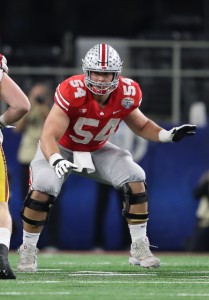 Considering the quarterback expense(s) likely coming, Minnesota using a first-round pick on a blocker would make sense. While its lofty Matt Kalil choice didn’t end up panning out, it’s time to use another high selection on a lineman. Remmers and Reiff will be 29 this year, and neither’s ceiling is particularly high entering their seventh seasons.
Considering the quarterback expense(s) likely coming, Minnesota using a first-round pick on a blocker would make sense. While its lofty Matt Kalil choice didn’t end up panning out, it’s time to use another high selection on a lineman. Remmers and Reiff will be 29 this year, and neither’s ceiling is particularly high entering their seventh seasons.
Both Matt Miller of Bleacher Report and NFL.com’s Lance Zierlein have Minnesota taking a tackle in Round 1. Late-first-round tackle options include Notre Dame’s Mike McGlinchey, UCLA’s Kolton Miller and Texas’ Connor Williams.
It’s unlikely the Vikings will have their choice of these players by the No. 30 window in a draft that’s viewed as being better on offensive linemen than 2017’s, but one of them could well be there.
Georgia’s Isaiah Wynn could be a guard option, with the ex-Bulldogs standout being a candidate at 6-foot-2 to move inside. Billy Price — Elflein’s Ohio State teammate — suffered a potentially significant pectoral injury, which required surgery, and that could push him into the late first round or possibly out of it altogether.
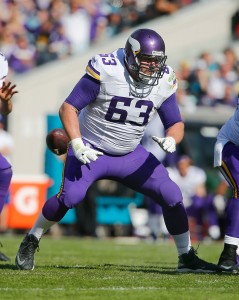 There are options for the Vikings a year after few existed in Round 1 at these positions. And with re-ups for several Zimmer-era cornerstones coming soon, a potential record QB salary on tap, and factoring in the ages of last year’s UFA additions, Minnesota should strongly consider going this route to address this key need.
There are options for the Vikings a year after few existed in Round 1 at these positions. And with re-ups for several Zimmer-era cornerstones coming soon, a potential record QB salary on tap, and factoring in the ages of last year’s UFA additions, Minnesota should strongly consider going this route to address this key need.
A cheap-ish stopgap and a first-round pick wouldn’t be the worst way to go about addressing the front this offseason.
Last year showed younger linemen being in high demand. That makes sense due to the league-wide issues experienced in developing young talent. Remmers and Reiff were notable examples, with Kalil’s Panthers pact being perhaps the signature deal to illustrate this seller’s market. But there are options if Minnesota wants to spend low- to mid-level amounts here before the draft. The guard market looks to have more depth than the tackle contingent, so it might be best for the Vikings to focus their efforts there, if veteran help is desired.
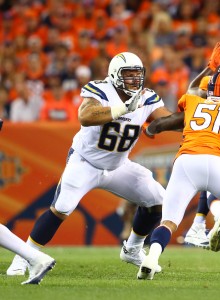 Longtime Vikes guard Brandon Fusco will hit the market, and despite being released early last year after a shaky 2016, he still profiles as an upper-echelon quick-fix candidate. Just 29, Fusco bounced back from a shakier 2016 and graded as PFF’s No. 21 guard while with the 49ers. If Berger ventures elsewhere, his younger ex-teammate would be an interesting option.
Longtime Vikes guard Brandon Fusco will hit the market, and despite being released early last year after a shaky 2016, he still profiles as an upper-echelon quick-fix candidate. Just 29, Fusco bounced back from a shakier 2016 and graded as PFF’s No. 21 guard while with the 49ers. If Berger ventures elsewhere, his younger ex-teammate would be an interesting option.
Ryan Jensen may price himself out of mid-level status, but he has experience at guard despite his 2017 work as the Ravens’ center. Zach Fulton has experience at multiple interior positions as well. Although, like recent Chiefs contract-year wonder Jeff Allen, Fulton is a buyer-beware blocker who hasn’t shown much consistency. Would the Vikings want to bring Matt Slauson back to the NFC North? He did not have as good of a season in 2017 as he did with the 2016 Chargers or previous Bears editions, but that could bring his price down to buy-low range.
The Vikings are in a good place, but they do need to supply their front with more talent this offseason. If they can hit on one of those investments, it could mark a more difficult Packers task unseating the Vikings than it was in 2016.
New colors. Noone likes purple.
Really? That’s what you got out of this
I had the patriots beating vikings in super bowl 52 …
HAAAAA!
EVERYONE loves the purple!
They don’t need a lot of pieces. Obviously Cousins would be an upgrade, but a $90 mil guarantee is crazy. Maybe $50 guaranteed over the deal which could be $90 plus. This isn’t baseball.
Vikes Are still stacked. They are just upgrading a super bowl probable.
What do you see the Vikes doing at QB?
It’s the Vikings. Name me the last time they went to the playoffs in back to back seasons. Here’s a hint: It was back in the 90s.
They’ll find a way to screw it up.